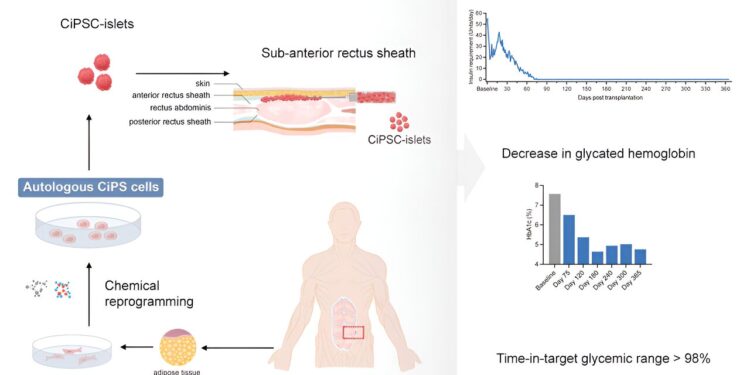Credit: Cell (2024). DOI: 10.1016/j.cell.2024.09.004
A team of medical researchers affiliated with a large number of institutions in China functionally cured a patient with type 1 diabetes by injecting her with programmed stem cells.
For their study published in the journal Cellthe group extracted cells from the patient, returned them to a pluripotent state, programmed them to grow into pancreatic islets, then reinjected them into her abdomen.
Over the past decade, stem cell research has progressed dramatically. Scientists have programmed them to become organoids, biological organs and tissues. They have also been used to treat conditions such as muscle damage and sickle cell disease. In this new study, researchers used them to replace pancreatic islets lost due to an immune response gone awry, leading to type 1 diabetes.
For unknown reasons, some people experience an immune crisis resulting in the destruction of the islets in the pancreas responsible for insulin production. These incidents usually occur during adolescence, which is why the disease is also known as juvenile diabetes.
Because the islets are destroyed, any cure for the disease must involve replacing them in some way, either by transplantation from a donor, or in this new example, using the person’s own cells as a basis for creating pluripotent stem cells, which can be programmed. to transform into replacement islands.
In this new effort, the researchers collected cells from three type 1 diabetic patients: all cells were returned to a pluripotent state and then programmed to develop into pancreatic islets. The researchers note that they modified the standard approach by exposing cells to certain molecules rather than introducing proteins. The patient treatment process was staggered over time so that the results from the first patient could be applied to the second, then the third.
In a procedure lasting about 30 minutes, the researchers injected 1.5 million islets they had grown into the abdomen of the first patient, a 25-year-old woman. Placing them in the abdomen allowed for easy monitoring and removal if necessary. Two and a half months later, tests showed that the patient was producing enough of her own insulin to stop the injections.
After a year, she was still producing her own insulin. The research team notes that the patient was already receiving immunosuppressive medications due to a prior liver transplant; Thus, it is still unclear whether her immune system will repeat the type of attack that caused her to suffer from type 1 diabetes in the first place.
More information:
Shusen Wang et al, Transplantation of islets derived from chemically induced pluripotent stem cells under the anterior rectus abdominal sheath in a type 1 diabetic patient, Cell (2024). DOI: 10.1016/j.cell.2024.09.004
Cell
© 2024 Science X Network
Quote: Patient with type 1 diabetes functionally cured thanks to stem cell injections (September 30, 2024) retrieved September 30, 2024 from
This document is subject to copyright. Except for fair use for private study or research purposes, no part may be reproduced without written permission. The content is provided for informational purposes only.



